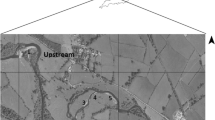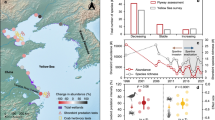Abstract
Ephemeral wetlands commonly experience events that would be drastic disturbances in permanent aquatic ecosystems, such as the elimination of all water. It is well known that survival in these harsh habitats requires flexibility in response to natural perturbations, but scientists have rarely investigated if this flexibility translates to anthropogenic stresses. Therefore, we evaluated aquatic crustacean communities in ephemeral wetlands in response to environmental and anthropogenic constraints. We sampled crustacean communities from 73 ephemeral wetlands across 5 states of the North American high plains. Neither habitat size, habitat depth, nor whether a wetland was natural or artificially created had any recognizable effect on the crustacean community. Moreover, natural communities have great flexibility, which seems to impart resilience under some anthropogenic forces. Communities of artificial waterbodies (roadside ditches and stock ponds) were indistinguishable from those in naturally formed wetlands. Cattle grazing, which in some ways resembles effects of native vertebrate grazers, was generally associated with increased invertebrate densities and richness. In contrast, tilling for row-crop agriculture decreased invertebrate density and richness. Overall, current conservation strategies in ephemeral wetlands may need to be revised to include artificial habitats as viable, important habitats, and cattle grazing as an essential ecosystem component in areas now lacking large native grazers, such as bison.


Similar content being viewed by others
References
Anderson JT, Smith LM (2000) Invertebrate response to moist-soil management of playa wetlands. Ecol Appl 10:550–558
Anderson JT, Smith LM (2004) Persistence and colonization strategies of playa wetland invertebrates. Hydrobiologia 513:77–86
Bartzen BA, Dufour KW, Clark RG, Caswell FD (2010) Trends in agricultural impact and recovery of wetlands in prairie Canada. Ecol Appl 20:525–538
Batzer DP (2013) The seemingly intractable ecological responses of invertebrates in North American wetlands: a review. Wetlands 33:1–15
Bentley PJ (1966) Adaptations of Amphibia to arid environments. Science 152:619–623
Bilton DT, Foggo A, Rundle SD (2001) Size, permanence and the proportion of predators in ponds. Arch Hydrobiol 151:451–458
Bremer DJ, Auen LM, Ham JM, Owensby CE (2001) Evapotranspiration in a prairie ecosystem: effects of grazing by cattle. Agron J 93:338–348
Brendonck L, Michels E, De Meester L, Riddoch BJ (2002) Temporary pools are not enemy free. Hydrobiologia 486:147–159
Collins SL (1987) Interaction of disturbances in tallgrass prairie: a field experiment. Ecology 68:1243–1250
Devictor V, Moret J, Machon N (2007) Impact of ploughing on soil seed bank dynamics in temporary pools. Plant Ecol 192:45–53
Elphick CS (2000) Functional equivalency between rice fields and seminatural wetland habitats. Conserv Biol 14:181–191
Eriksen CH (1966) Diurnal limnology of two highly turbid puddles. Verh Int Ver Limnol 16:507–514
Euliss NH, LaBaugh JW, Fredrickson LH, Mushet DM, Laubhan MK, Swanson GA, Winter TC, Rosenberry DO, Nelson RD (2004) The wetland continuum: a conceptual framework for interpreting biological studies. Wetlands 24:448–458
Evans CS (2010) Playas in Kansas and the High Plains. Kans Geol Surv Public inform Circ 30:1–6
Fleischner TL (1994) Ecological costs of livestock grazing in western North America. Conserv Biol 83:629–644
Garmendia A, Pedrola-Monfort J (2010) Simulation model comparing the hydroperiod of temporary ponds with different shapes. Limnetica 29:145–152
Gascón S, Boix D, Sala J, Quintana XD (2005) Variability of benthic assemblages in relation to the hydrological pattern in Mediterranean salt marshes (Emporda wetlands, NE Iberian Peninsula). Arch Hydrobiol 163:163–181
Gerlanc NM, Kaufman GA (2003) Use of bison wallows by anurans on Konza Prairie. Am Midl Nat 150:158–168
Gleason RA, Euliss NH Jr (1998) Sedimentation of prairie wetlands. Great Plains Res 8:97–112
Gleason RA, Euliss NH Jr, Hubbard DE, Duffy WG (2003) Effects of sediment load on emergence of aquatic invertebrates and plants from wetland soil egg and seed banks. Wetlands 23:26–34
Gurdak JJ, Roe CD (2009) Recharge and chemistry beneath playas of the high plains aquifer—a literature review and synthesis: U.S. Geological Survey. Circular 1333(39):73–80
Hall DL, Willig MR, Moorhead DL, Sites RW, Fish EB, Mollhagen TR (2004) Aquatic macroinvertebrate diversity of playa wetlands: the role of landscape and island biogeographic characteristics. Wetlands 24:77–91
Hartnett DC, Hickman KR, Fischer-Walter LE (1996) Effects of bison grazing, fire and topography on floristic diversity in tallgrass prairie. J Range Manag 49:413–420
Haukos DA, Smith LM (1992) Ecology of Playa Lakes. United State Department of the Interior Fish and Wildlife Service Fish and Wildlife Leaflet 13.3.7, Washington, DC
Haukos DA, Smith LM (2003) Past and future impacts of wetland regulations on playa ecology in the southern Great Plains. Wetlands 23:577–589
Hernandez KM, Reece BA, McIntyre NE (2006) Effects of anthropogenic land use on Odonata in playas of the southern High Plains. West N Am Nat 66:273–278
Huner JV, Clinton WJ, Norling W (2002) Managing agricultural wetland for waterbirds in the coastal regions of Louisiana, USA. Waterbirds 25:66–78
Johnson P, Rogers G (2003) Ephemeral wetlands and their turfs in New Zealand. Science for Conservation. 230. New Zealand Department of Conservation, Wellington
Johnson LA, Haukos DA, Smith LM, McMurry ST (2012) Physical loss and modification of Southern Great Plains playas. J Environ Manag 112:275–283
Knapp AK, Blair JM, Briggs JM, Collins SL, Hartnett DC, Johnson LC, Towne EG (1999) The keystone role of bison in North American tallgrass prairie. BioScience 49:39–50
Li D, Chen S, Lloyd H, Zhu S, Shan K, Zhang Z (2013) The importance of artificial habitats to migratory waterbirds within a natural/artificial wetland mosaic, Yellow River Delta, China. Bird Conserv Int 23:184–198
Longoni V (2010) Rice fields and waterbirds in the Mediterranean region and the Middle East. Waterbirds 22:83–96
Luo HR, Smith LM, Allen BL, Haukos DA (1997) Effects of sedimentation on playa wetland volume. Ecol Appl 7:247–252
Marty JT (2005) Effects of cattle grazing on diversity in ephemeral wetlands. Conserv Biol 19:1626–1632
McCune B, Grace JB (2002) Analysis of ecological communities. MjM Software Design, Gleneden
O’Neill BJ, Thorp JH (2014) Untangling food-web structure in an ephemeral ecosystem. Freshw Biol 59:1462–1473
Paradise CJ, Dunson WA (1998) Relationship of atmospheric deposition to the water chemistry and biota of treehole habitats. Environ Toxicol Chem 17:362–368
Pyke CR, Marty J (2005) Cattle grazing mediates climate change impacts on ephemeral wetlands. Conserv Biol 19:1619–1625
Robertson AI, Rowling RW (2000) Effects of livestock on riparian zone vegetation in an Australian dryland river. Regul Rivers 16:527–541
Rogers DC (1998) Aquatic macroinvertebrate occurrences and population trends in constructed and natural vernal pools in Folsom, California. In: Witham CW, Bauder ET, Belk D, Ferrin WR Jr, Orduff R (eds) Ecology, conservation, and management of vernal pool ecosystems-proceedings from a 1996 conference. California Native Plant Society, Sacramento, pp 224–235
Rogers DC (2014) Larger hatching fractions in avian dispersed anostracan eggs (Branchiopoda). J Crust Biol 34:135–143
Sayre NF, Carlisle L, Huntsinger L, Fisher G, Shattuck A (2012) The role of rangelands in diversified farming systems: innovations, obstacle, and opportunities in the USA. Ecol Soc 17:43
Sim LL, Davis JA, Strehlow K, McGuire M, Trayler KM, Wild S, Papas PJ, O’Connor J (2013) The influence of changing hydroregime on the invertebrate communities of temporary seasonal wetlands. Freshw Sci 32:327–342
Smith LM (2003) Playas of the Great Plains. University of Texas Press, Austin
Spencer M, Blaustein L, Schwart SS, Cohen JE (1999) Species richness and the proportion of predatory animal species in temporary freshwater pools: relationships with habitat size and permanence. Ecol Lett 2:157–166
Thurman EM, Bastian KC, Mollhagen T (2000) Occurrence of cotton herbicide and insecticides in playa lakes of the High Plains of West Texas. Sci Total Environ 248:189–200
Vanschoenwinkel B, Waterkeyn A, Vandecaetsbeek T, Pineau O, Grillas P, Brendonck L (2008) Zooplankton dispersal by large terrestrial mammals- a case study on wild boar (Sus scrofa) in Southern France. Freshw Biol 54:2264–2273
Vanschoenwinkel B, Hulsmans A, De Roeck E, De Vries C, Seaman M, Brendonck L (2009) Community structure in temporary freshwater pools: disentangling the effects of habitat size and hydroregime. Freshw Biol 54:1487–1500
Vanschoenwinkel B, Waterkeyn A, Nhiwatiwa T, Pinceel T, Spooren E, Geerts A, Clegg B, Brendonck L (2011) Passive external transport of freshwater invertebrates by elephant and other mud-wallowing mammals in an African savannah habitat. Freshw Biol 56:1606–1619
Waterkeyn A, Grillas P, Vanschoenwinkel B, Brendonck L (2008) Invertebrate community patterns in Mediterranean temporary wetlands along hydroperiod and salinity gradients. Freshw Biol 53:1808–1822
Wiggins GB, Mackay RJ, Smith IM (1980) Evolutionary and ecological strategies of animals in annual temporary pools. Arch Hydrobiol 58:97–206
Williams D (2006) The biology of temporary waters. Oxford University Press, Oxford
Young FN, Zimmerman JR (1996) Variations in temperature in small aquatic situations. Ecology 37:609–611
Zedler JB, Kercher S (2005) Wetland resources: status trends, ecosystem services, and restorability. Annu Rev Environ Resour 30:39–74
Acknowledgments
We thank Anne Bartuszevige, the Playa Lakes Joint Venture, and the Rocky Mountain Bird Observatory for assistance in finding wetland sites. Our study was funded by the Region 8 office in Denver of the Environmental Protection Agency (CD968115-01), with additional support for DCR and JHT from EPA Region 7 (CD 97739901); however, conclusions of this study do not necessarily reflect EPA policy.
Author information
Authors and Affiliations
Corresponding author
Appendix
Rights and permissions
About this article
Cite this article
O’Neill, B.J., Rogers, D.C. & Thorp, J.H. Flexibility of ephemeral wetland crustaceans: environmental constraints and anthropogenic impacts. Wetlands Ecol Manage 24, 279–291 (2016). https://doi.org/10.1007/s11273-015-9455-x
Received:
Accepted:
Published:
Issue Date:
DOI: https://doi.org/10.1007/s11273-015-9455-x




